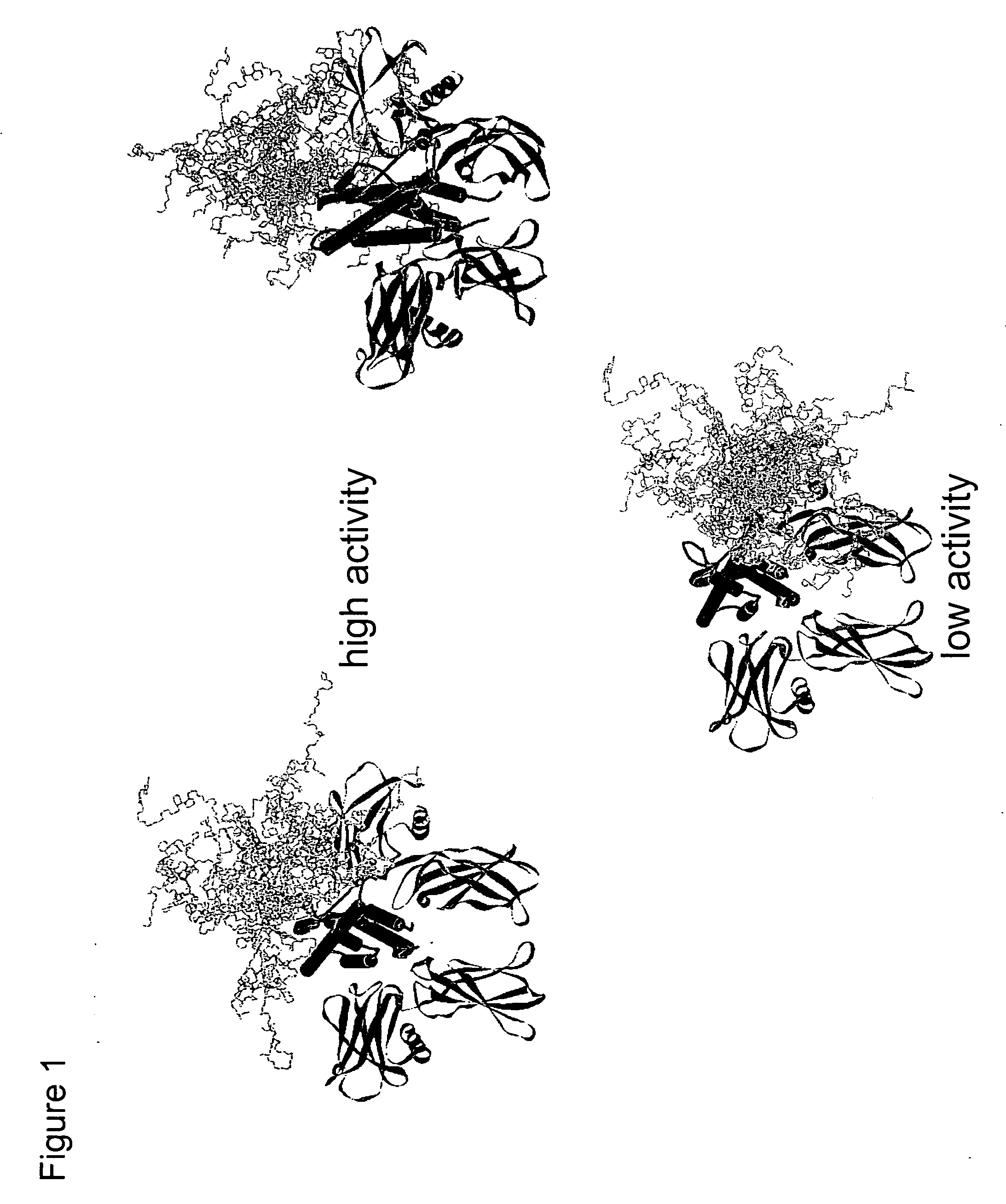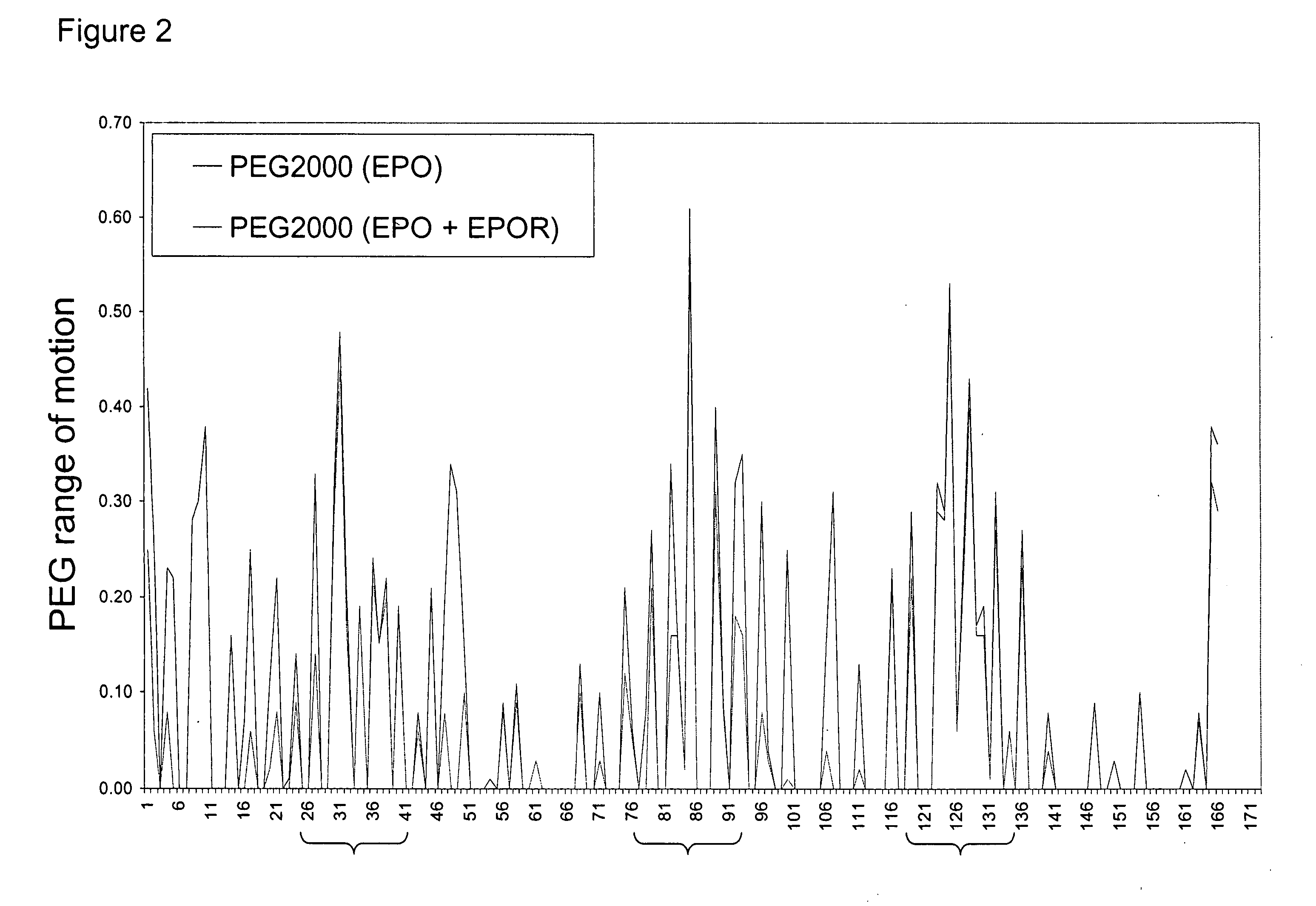Methods for rational pegylation of proteins
a pegylation method and protein technology, applied in the field of rational pegylation of proteins, can solve the problems of significant reduction of specific activity relative to unmodified proteins, at the expense of specific activity, and the difficulty of seeking peg attachment sites for pegylated therapeutics, and achieve the effect of reducing specific activity and specific activity
- Summary
- Abstract
- Description
- Claims
- Application Information
AI Technical Summary
Benefits of technology
Problems solved by technology
Method used
Image
Examples
example 1
Optimized PEGylation of Erythropoietin
[0080] It is well known in the art that non-glycosylated erythropoietin (EPO) and EPO variants do not possess significant levels of in vivo biological activity. This is most likely a result of the rapid in vivo turnover of non-glycosylated EPO. Site-specific incorporation of glycosylation sites serves as a successful approach for improving PK. A notable example is Amgen's hyperglycosylated erythropoietin variant Aranesp® (darbepoetin alfa), engineered to contain two additional N-linked glycosylation sites. The additional glycosylation increases the serum half-life 3-fold. However, the same modifications reduce in vitro specific activity roughly 4-fold, indicating a need for EPO analogs that have both improved PK and high specific activity. There is a thus need for improvements in chemical or posttranslational modification of proteins to modification sites that maximally improve pharmacokinetic properties while minimizing the effect on the struc...
example 2
Optimized PEGylation of a Dominant-Negative TNF
[0083] Although cytokine-receptor binding is a common consideration for the design of optimal protein therapeutics, other mechanisms of action are possible. These mechanisms dictate that other considerations are necessary for optimization of PEG attachment sites. The development of dominant-negative variants of TNF for the inhibition of endogenous TNF serves as a useful example (see U.S. Ser. No 10 / 262,630, filed Sep. 30, 2002; U.S. Ser. No. 09 / 981,289, filed Oct. 15, 2001; U.S. Ser. No. 09 / 945,150, filed Aug. 31, 2001; U.S. Ser. No. 09 / 798,789, filed Mar. 2, 2001; U.S. Ser. No. 60 / 186,427, filed Mar. 2, 2000; U.S. Ser. No. 60 / 510,454, filed Oct. 10, 2003; U.S. Ser. No. 60 / 509,960, filed Oct. 9, 2003; and U.S. Ser. No. 60 / 528,276, filed Dec. 8, 2003, all of which are incorporated by reference in their entirety).
[0084] The active form of TNF is a noncovalent trimer. Dominant-negative variants of TNF (DN-TNF) have been created by removi...
example 3
Optimized PEGylation of Human Growth Hormone (HGH)
[0085] HGH is used to treat growth-related disorders. As with most therapeutic proteins, its PEGylation is expected to improve its pharmacokinetic properties in a patient. The methods of the present invention have been used to select optimal PEGylation sites in HGH (see FIG. 6). Further analysis of the simulation data indicate that optimal PEGylation sites on HGH include, but are not limited to Ala155, Ser95, Thr135, Pro133, Ser57, Lys158, Asp154, Asn99, Lys140, Lys145, and Asp147, or equivalent positions in variants. As discussed above, site specific PEGylation at any of these or other positions would require replacement of the native amino acid with a suitable amino acid such as cysteine. Alternatively, because Lys158 and Lys145 are good PEGylation sites, all other lysines in HGH can be replaced so that specific PEGylation at positions 145 and 158 is enabled.
PUM
| Property | Measurement | Unit |
|---|---|---|
| Mass | aaaaa | aaaaa |
| Mass | aaaaa | aaaaa |
| Size | aaaaa | aaaaa |
Abstract
Description
Claims
Application Information
 Login to View More
Login to View More - R&D
- Intellectual Property
- Life Sciences
- Materials
- Tech Scout
- Unparalleled Data Quality
- Higher Quality Content
- 60% Fewer Hallucinations
Browse by: Latest US Patents, China's latest patents, Technical Efficacy Thesaurus, Application Domain, Technology Topic, Popular Technical Reports.
© 2025 PatSnap. All rights reserved.Legal|Privacy policy|Modern Slavery Act Transparency Statement|Sitemap|About US| Contact US: help@patsnap.com



